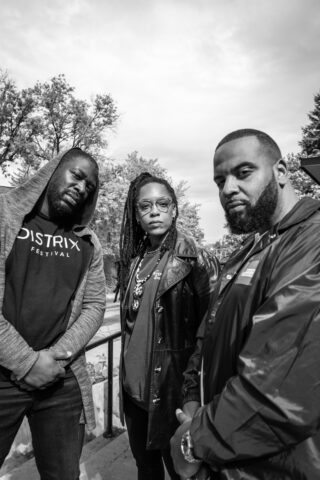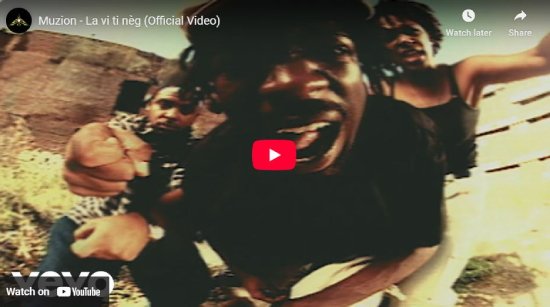Muzion’s legendary story is still being written. More than a quarter of a century after leaving an indelible mark on Québec’s hip-hop scene with their first album, the band will receive the Cultural Impact Award at the 2025 Gala SOCAN held on May 4, 2025, at La TOHU in Montréal.
 The trio, hailing from Montréal’s Saint-Michel neighbourhood, will receive the coveted award to celebrate the immense impact of its seminal hit “La Vi Ti-Neg.” It will mark the first time in the Gala’s 34-year history that this honour goes to a hip-hop song.
The trio, hailing from Montréal’s Saint-Michel neighbourhood, will receive the coveted award to celebrate the immense impact of its seminal hit “La Vi Ti-Neg.” It will mark the first time in the Gala’s 34-year history that this honour goes to a hip-hop song.
Jenny Salgado, a.k.a. J.Kyll, wrote the music, a lively mix of hip-hop and kompa. “The song is an urge,” she says. “An urge to reach back into our heritage, back to the music we would listen to at home, and back to the records my parents passed on to me. I would often go to Haitian dances, and I could see the impact that kompa bands had on the audience. They could play the same song, with a steady beat, for 15 minutes, and everyone would dance. I wanted to incorporate that colour into hip-hop.”
After coming up with the skeleton of the song around a kompa sample, Salgado headed to the studio with Muzion – the other members being Dramatik, Imposs and, at the time, LD-One – to create a full version. Harold Faustin, one of Haiti’s greatest guitar players, brought his magic touch. “The song became more progressive,” says Salgado. “We moved away from the loop. What’s special here is that, initially, we didn’t want to include it on the album. It had a very clear direction, but a dark one! [Laughs] We were delving into very deep stuff, raw, very lyrics-oriented. But on ‘La Vi Ti-Neg,’ we were definitely in a much more festive mode. We felt it didn’t fit in, but when we saw the song’s impact during our shows [before the album was released], we knew we had something that was out of our control.”
This use of traditional Haitian music has now become commonplace in R&B and pop, as we’ve heard in the hybrid musical stylings of Aya Nakamura or Joé Dwèt Filé, both international stars. Raccoon, a prominent figure in Québec’s rap scene at the time, recognizes the groundbreaking aspect of Muzion’s body of work. “It’s crazy to see Muzion being among the pioneers [of this kind of hybridization],” he says.
Muzion had always been part of Raccoon’s musical universe, as he was also born in Montréal’s East End. “It’s been part of my life since I was a little one,” he says. “I heard ‘La Vi Ti-Neg’ all over the place, at my cousin’s, at family reunions… It was only later, when I was 10 or 11, that I saw the music video on MusiquePlus. I was transfixed! I saw places from my neighbourhood in the video. I saw all these Haitians and Black people represented on mainstream TV. It really resonated with me.
“To me, they’re legends and trailblazers,” he adds. “These are people who showed me that it was possible for a young boy from a Haitian family and immigrant parents to live their dreams. I do remember feeling like I wanted to become an artist after seeing that video.”

Left to right: Sarahmée, Webster, Raccoon
Muzion was also a major source of inspiration for Sarahmée. It’s worth remembering that back then, Jenny Salgado was one of the very few women on the Québec rap scene to enjoy a modicum of media visibility. “All female rappers from Québec that came before me were inspirations,” says Sarahmée. “but the one I saw on TV was Jenny. I didn’t know what I wanted to do in life yet, but I told myself that if that woman could be where she was, so could I. I was enthralled by her.
“‘La Vi Ti-Neg’ is an anthem,” she adds. “I’m of Senegalese origin, so I don’t speak Haitian creole, but I could still understand the message, the strength, the resilience, and the solidarity. That song transcends music; it transcends rap.”
Just like Sarahmée, Webster remembers vividly the first time he saw the band on TV. “Muzion is part of the saintly quartet of ‘rap Québ.’ alongside Yvon Krevé, Rainmen, and Sans Pression,” he says. “When I saw them, I thought to myself, ‘Wow! There are people like us doing this, and they’re fucking great at it!’ Webster started his rap journey with Northern X in Québec City in the mid-’90s. “Even though I’m not Haitian, I felt, as a Senegalese man, a proximity with Muzion’s work, and this idea of proudly waving the flag of our Afro roots in a mostly white universe. This idea of proclaiming one’s African heritage touched me directly.”
As was the case with Webster, Biz had already started rapping when he heard Muzion for the first time. “We were working on Manifestif [Loco Locass’ debut album, released in 2000] when Muzion and Sans Pression came out. We realized there was stiff competition on the horizon. This was the big leagues, and the going would get rough. We were happy about it, though, because it meant we would be part of a collective movement, a wave. You often hear that Lil Wayne is a rapper’s rapper. Well, Muzion and SP were also rappers’ rappers. It was the NHL. When they exploded, we were super-motivated. It pulled us up. Emulation is a powerful force in the rap world. There’s a culture of ego, but at least it pulls you upward. That’s how I saw it. Muzion tell me about their neighbourhood, their ‘hood. I’m going to talk about my ‘hood, but on a national scale. My ‘hood is Québec as a whole.”
For Muzion, this ‘hood encompasses areas on the Northern side of Montréal, where there’s a lot of Haitians, especially Saint-Michel, Montréal North, Rivière-des-Prairies, and Cartierville, the four main locations where the music video for “La Vi Ti-Neg” was filmed, in a frantic, festive atmosphere. “That song is a bit like our ‘Alright,’ by Kendrick Lamar, says Salgado. “Despite what some see as being outsiders, miserable, and somewhat ghettoized, despite all the labels others might want to stick on us, we wanted to tell, to shout, that we’re still having fun, we’re still alive, and that what unites us isn’t suffering. But we couldn’t have imagined it would snowball like it did. The song spilled out of the neighbourhood and resonated with the entire province.”
According to Raccoon, “It’s an homage to Montréal’s community of young Haitians. It’s our anthem. It’s the song that represented us the most in the mainstream. And it’s also a very Haitian song at its core. Because, you see, despite all that we endure, Haitians are very festive people, who’ll find any reason to celebrate. Even if we face hurdles on a daily basis, we will always look for an opportunity to dance, bob our heads, and try to forget our worries for a brief moment.”
Says Webster, “That song is the embodiment of a reality Québec was unaware of. This historical and social reality existed, but it didn’t permeate the media and cultural spheres. Then came these people from Saint-Michel, with their creole slang, saying, ‘This is the face of Québec you’ve never seen. The face that’s from neighbourhoods you don’t want to see.’“
Biz says that it’s precisely this mix of Québec and Haitian identities that make Muzion and their song an essential part of local culture. “I’ve always loved Muzion’s drive to claim they are ‘Québécois,’ without burning the bridges to their Haitian roots,” he says. “They’re both compatible identities that can be mixed in music. Muzion and I have deep mutual respect. They’re humans that I deeply respect and whom I’ve worked alongside for 25 years. I’m really proud that they’re being presented with this award.”
The honour is very significant for Jenny Salgado, who reminds us that “La Vi Ti-Neg” was shunned by commercial radio back in the day. The band and their record label, BMG Québec, bought a full-page ad in the arts weekly Voir to communicate a very clear message. “It said, in big, bold letters, ‘FUCK COMMERCIAL RADIO.’ The message we wanted to get across was simply, ‘With or without your help, we’re going to make it big.’ In hindsight, I think the fact that the song was so popular without the help of the industry is what gave it such longevity. It has a life of its own, one that the audience chose for it.”
“I do think the song benefitted from the fact that it was shunned,” agrees Biz. “If it had been played on the radio for a whole summer, we’d probably be tired of hearing it… but we’re still talking about it today. Its longevity is more like grains of sand in an hourglass. I do believe this strengthens its capacity to touch people.”
And let’s be clear, its impact reaches far beyond Québec. The renowned Wyclef Jean was, back then, openly impressed by the song, and the way it mixed genres. “Wyclef told me that it was the first time ever that we heard kompa in a rap song,” remembers Salgado. “And that’s one of the reasons he invited us to work with him. He heard an unexpected musical colour. After that, the song carried on its own path, way beyond ours. It travelled the entire world.”
And it’s finally at home – where, at last, it’ll be honoured as it should be.
